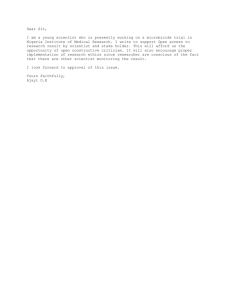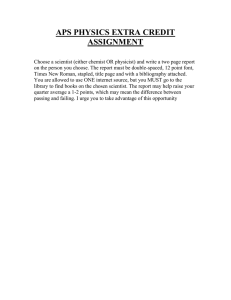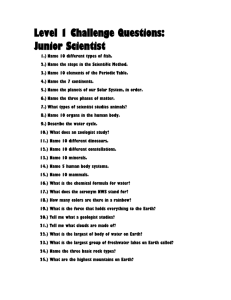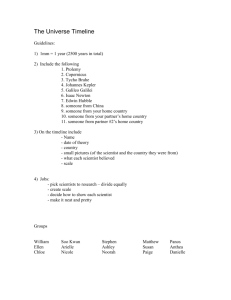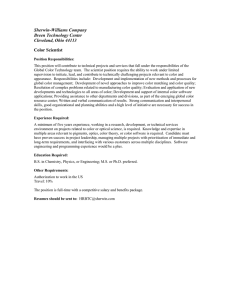From High School Teaching to Designing Curriculum
advertisement
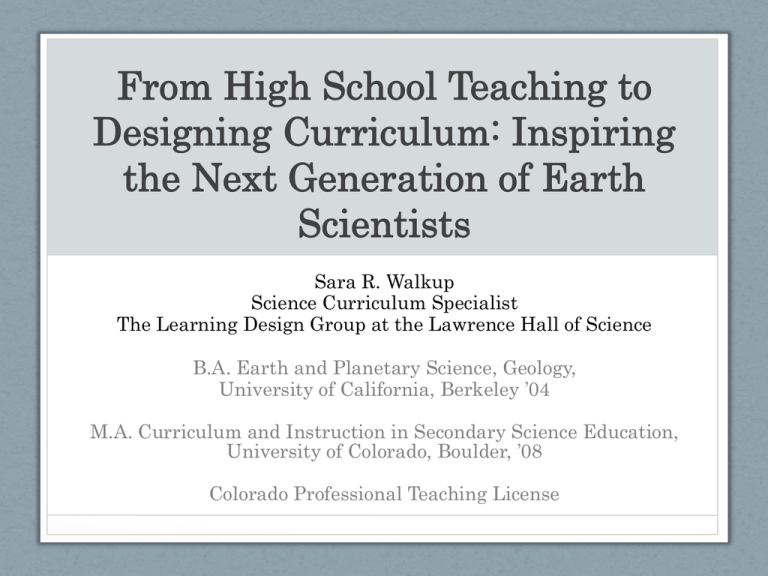
From High School Teaching to Designing Curriculum: Inspiring the Next Generation of Earth Scientists Sara R. Walkup Science Curriculum Specialist The Learning Design Group at the Lawrence Hall of Science B.A. Earth and Planetary Science, Geology, University of California, Berkeley ’04 M.A. Curriculum and Instruction in Secondary Science Education, University of Colorado, Boulder, ’08 Colorado Professional Teaching License Agenda 1. Draw A Scientist Activity and Discussion 2. The Real Deal on High School Science Teaching 3. Science Curriculum Development with the Learning Design Group at the Lawrence Hall of Science 4. Questions and Comments Activity On your own, draw a picture of a scientist. Turn and Talk Turn and talk to a partner about your scientist drawing. Some questions for partner discussion: • Why did you draw the scientist the way you did? • What tools does the scientist in your drawing use? • What informed your decisions about drawing your scientist the way you did? Share Share what you or your partner talked about with the group. • Why did you draw the scientist the way you did? • What tools does the scientist in your drawing use? • What informed your decisions about drawing your scientist the way you did? The Scientist “The scientist is a man who wears a white lab coat and works in a laboratory. He is elderly or middle aged and wears glasses…he may wear a beard…he is surrounded by equipment: test tubes, bunsen burners, flasks and bottles, a jungle gym of blown glass tubes and weird machines with dials…he writes neatly in black notebooks…One day he may straighten up and shout: “I’ve found it! I’ve found it!”…Through his work people will have new and better products…he has to keep dangerous secrets…his work may be dangerous…he is always reading a book.” (Mead and Metraux, 1975, p 386, 387 as cited in Chambers, 1983) Why does this matter? “For example, Kahle (1988) stated that an individual’s perceptions of scientists are one aspect of attitudes toward science and that this may have an impact on the attention given to the study or teaching of science…. Hence, individuals who have negative perceptions of science or of scientists are unlikely to pursue science courses of study and, subsequently, enter a science/ science-related career (Hammrich, 1997). ” Finson, Kevin D. "Drawing a scientist: What we do and do not know after fifty years of drawings." School science and mathematics 102.7 (2002): 335-345. Minorities in Geosciences “Data spanning the time period from 1995-2001 indicated that the percentage of bachelor's’ and master’s degrees awarded to members of racial and ethnic groups that are underrepresented in the STEM fields was lower in the geosciences than in any other STEM field.” Huntoon, Jacqueline E., and Melissa J. Lane. "Diversity in the geosciences and successful strategies for increasing diversity." Journal of Geoscience Education 55.6 (2007): 447. Women in Science “In communities where a higher percentage of working women are employed in STEM occupations, larger gender stereotypes at the societal level may be subverted by a picture of what is possible that differs from that typically associated with more traditional gender roles.” Riegle‐Crumb, Catherine, and Chelsea Moore. "The Gender Gap in High School Physics: Considering the Context of Local Communities." Social Science Quarterly (2013). My Path to Science Teaching 2004 - Graduated with a B. A. in Geology from the EPS Department at UC Berkeley. 2006- Returned to graduate school to earn my M.A. degree in Curriculum and Instruction in Secondary Science Education from the University of Colorado at Boulder. As part of my master’s coursework, I completed the requirements for a Colorado Initial Teaching License with a Science Endorsement. 2008 - Began teaching high school science at a secondary school in Denver Public School District. High School Science Teaching My School • Middle School and High School (grades 6-12) in one building. • Most students spoke English as their second language with Spanish as their first language. • Over 90% of students qualified for free or reduced lunch. My Teaching Assignment • I taught 9th grade Earth Science, 11th grade Chemistry, and 12th grade Physics. • Used an inquiry-based curriculum for all courses which was selected and purchased by the district. • Leadership at my school requested that I enact the curriculum with fidelity, but make appropriate modifications for my unique learners. What does a science teacher do? • Engages students in activities that allow them to see themselves as scientists engaging in the authentic practices of science. • Reveals the connection science has to a student’s everyday life. • Challenges students to see the world from a new perspective. • Guides students as they build their conceptual understanding of science principles. That sounds great! What aren’t you telling me? A Science Teacher also… • Deals (gracefully?) with large-scale, high-stakes testing. • Determines a lot of student’s grades. • Takes and submits attendance in the window of time he or she is supposed to. • Manages 17 requests to go to the bathroom at the same time. • Cleans the lab sinks…a lot. • Offers emotional and academic support to 150 hormonal kids each and every day. • Offers emotional support to 75 stressed out colleagues each and every day. Engaging Students in Science What worked in my classroom: • Inquiry-based Learning Cycles Engage curiosity Elicit prior knowledge Explore a phenomena (usually hands-on) Explain how that phenomena works (usually through reading) • Extending knowledge by applying understanding to a new context or learning about a related phenomena • • • • Engaging Students in Science What worked in my classroom: • Authentic Science Practices • Inviting students to explore a topic as a scientist would • Cultivating scientific inquiry skills • Building habits of mind • Integrating scientific argumentation into the content • Science notebooks • Reflection Engaging Students in Science What worked in my classroom: • Language and Literacy Support • Explicit vocabulary instruction • Glossaries in science notebooks • Opportunities for speaking, reading, writing, and listening integrated into nearly every class session • Reading strategies while students read text • Graphic organizers The Call from the Hall Jacquey Barber, Director of the Learning Design Group at the Lawrence Hall of Science, and I have an initial conversation about her group’s work in October 2011. She explains her team is hiring science curriculum developers to join a project to bring the Seeds of Science/Roots of Reading model to middle school, with an educational technology focus. Seeds of Science/Roots of Reading Seeds of Science/Roots of Reading is a research –based integrated science and literacy program with: • Inquiry-based Learning Cycles • Authentic Science Practices • Language and Literacy Support www.scienceandliteracy.org Middle School Project • Takes all the best of the integrated science and literacy Seeds/Roots elementary school approach. • Is designed around the middle school Next Generation Science Standards. • Has a large focus on using and developing educational technology tools to enhance teacher and student learning. • Includes explicit instruction in scientific argumentation. What does a Science Curriculum Specialist do? Develops a research-based integrated science literacy program for middle school students. • Work on a team with a literacy specialist, simulation developer, and assistant developer to create a unit designed around the Next Generation Science Standards. • Pilot test curriculum under development in local schools. • Revise curriculum based on data from pilot testing. • Write the core science components of a unit in preparation for field test and wide-release. What’s next? • Working on my PhD with Susan McKinney, a professor at the Open University and the University of Twente in The Netherlands. • I will be studying how science curriculum developers design curriculum for successful implementation at scale. • Developing more middle school science curriculum! Questions? Comments? Please feel free to email me with any questions or comments. srwalkup@berkeley.edu Cal students can access the Lawrence Hall of Science for free with your ID, so please let me know if you are planning to come visit! I’d be happy to meet with you to discuss anything related to a career in science education.
